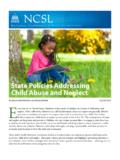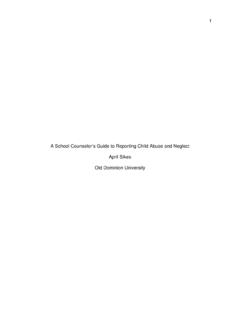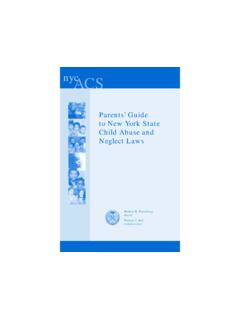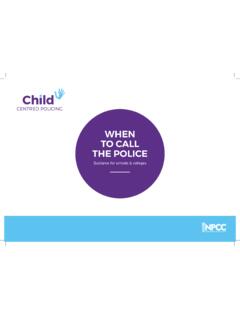Transcription of No secrets - GOV.UK
1 no secrets :Guidance on developing and implementingmulti-agency policies and procedures to protectvulnerable adults from abuseForewordThere can be no secrets and no hiding place when it comes toexposing the abuse of vulnerable adults. The Government s WhitePaper, Modernising Social Services , published at the end of 1998,signalled our intention to provide better protection for individualsneeding care and support. This is being taken up through the CareStandards are also committed to providing greater protection to victims andwitnesses, and the Government is actively implementing the measuresproposed in Speaking Up for Justice , the report on the treatment ofvulnerable or intimidated witnesses in the criminal justice system. Thatreport recognised that there were concerns about both the identificationand reporting of crime against vulnerable adults in care settings, andendorsed the proposals made by the Association of Directors of SocialServices, and others, that a national policy should be developed for theprotection of vulnerable adults.
2 It was agreed that local multi-agencycodes of practice would be the best way development of these codes of practice should be co-ordinatedlocally by each local authority social services department. To supportthis process this guidance is being issued under Section 7 of the LocalAuthority Social Services Act 1970. Government departments haveworked closely together on the preparation of this guidance and wecommend it to local authority social services departments, the policeservice, and the health service. It will also be of interest to theindependent sector, as well as users and carers. John HuttonJohn DenhamCharles ClarkeDepartment of HealthDepartment of HealthHome of this who is at risk and in what adults are vulnerable? constitutes abuse ? of may be the abuser? what circumstances may abuse occur? of degree of abuse justifies intervention? up an inter-agency framework of an inter-agency administrative multi-agency management and responsibilities within and between line management management authority officer and chief executive authority member and service from inter-agency elements of for staff and of services and contract for responding in individual objectives of an of and co-ordination of the response to the allegationofadult alleged to be responsible for abuse or poor discipline and criminal from of the message recruitment guidelines for all for users, carers and the general public paymentsAppendicesIProject Steering Group membershipIIReferences and suggested further readingIIIR elevant statutesContentsThis guidance has been produced by a Steering Group, led byPeterDunn of the Department of Health(DH)
3 Social Care Group, whichincluded representatives from a wide range of of the steering group is given in Appendix I and the DHthanks all those listed for their invaluable contribution. Annette YoungConsultant in the Management of Health and Social Care c k n o w l e d g e m e recent years several serious incidents have demonstrated the need forimmediate action to ensure that vulnerable adults, who are at risk ofabuse, receive protection and support. The Government gives a highpriority to such action and sees local statutory agencies and otherrelevant agencies as important partners in ensuring such action is takenwherever needed. This guidance builds on the Government s respect forhuman rights and results from its firm intention to close a significantgap in the delivery of those rights alongside the coming into force ofthe Human Rights Act aim should be to create a framework for action within which allresponsible agencies work together to ensure a coherent policy for theprotection of vulnerable adults at risk of abuse and a consistent andeffective response to any circumstances giving ground for concern orformal complaints or expressions of anxiety.
4 The agencies primary aimshould be to prevent abuse where possible but, if the preventivestrategy fails, agencies should ensure that robust procedures are in placefor dealing with incidents of abuse . The circumstances in which harmand exploitation occur are known to be extremely diverse, as is themembership of the at-risk group. The challenge has been to identify thenext step forward in responding to this 6 Section guidance is issued in furtherance of the Government s commitmentto develop such policies at national and local level. It is commended toall commissioners and providers of health and social care servicesincluding primary care groups, regulators of such care services andappropriate criminal justice agencies. These statutory agencies shouldwork together in partnership(as advocated in the Health Act 1999) toensure that appropriate policies, procedures and practices are in placeand implemented locally. They should do so in collaboration with allagencies involved in the public, voluntary and private sectors and theyshould also consult service users, their carers and representative groups.
5 Authority social services departments should play a co-ordinatingrole in developing the local policies and procedures for the protectionof vulnerable adults from abuse . Social services departments shouldnote that this guidance is issued under Section 7 of the Local AuthoritySocial Services Act 1970, which requires local authorities in their socialservices functions to act under the general guidance of the Secretary ofState. As such, this document does not have the full force of statute, butshould be complied with unless local circumstances indicate exceptionalreasons which justify a document gives guidance to local agencies who have aresponsibility to investigate and take action when a vulnerable adult isbelieved to be suffering abuse . It offers a structure and content for thedevelopment of local inter-agency policies, procedures and jointprotocolswhich will draw on good practice nationally and strategiesshould be developed, in all areas of the country,by all the statutory, voluntary and private agencies that work withvulnerable of this 2 covers issues of 3, 4, 5 and 6 provide guidance about the protection from abuseof vulnerable adults by the creation of a multi-agency administrativeframework (Section 3), the development of inter-agency policies andstrategies (Sections 4 and 5), and the formulation of inter-agencyoperational procedures designed to implement those policies wheninstances of abuse or suspected abuse come to light (Section 6).
6 Section7 discusses the provision of broader guidance for staff, users, carers andmembers of the developing operational guidance, local agencies shouldrefer to the publications dealing with the abuse of vulnerableadults which appear in Appendix 1 page 7* See also Making decisions a report issued in the light of responses to the consultationon the Law Commission s document (1999). WHO IS AT RISK AND IN WHAT defining abuse for the purpose of both national and local guidance itis important to clarify the following factors:Definitions which adults are vulnerable ? what actions or omissions constitute abuse ? who may be the abuser(s)? in what circumstances may abuse occur? patterns of abuse ; and what degree of abuse justifies intervention? adults are vulnerable?In this guidance adult means a personaged 18 years or broad definition of a vulnerable adult referred to in the 1997 Consultation Paper Who decides?,* issued by the Lord Chancellor sDepartment, is a person: who is or may be in need of community care services by reasonof mental or other disability, age or illness; and page 8 Section 2who is or may be unable to take care of him or herself,orunableto protect him or herself against significant harmorexploitation.
7 The purposes of this guidance community care services will betaken to include all care services provided in any setting or constitutes abuse ?In drawing up guidance locally, it needstobe recognised that the term abuse can be subject to wideinterpretation. The starting point for a definition is the followingstatement: abuse is a violation of an individual s human and civil rights byany other person or giving substance to that statement, however, consideration needs tobe given to a number of may consist of a single act or repeated acts. It may be physical,verbal or psychological, it may be an act of neglect or an omission toact, or it may occur when a vulnerable person is persuaded to enterinto a financial or sexual transaction to which he or she has notconsented, or cannot consent. abuse can occur in any relationship andmay result in significant harm to, or exploitation of, the personsubjected to it. consensus has emerged identifying the following main different formsof abuse : physical abuse ,including hitting, slapping, pushing, kicking, misuseof medication, restraint, or inappropriate sanctions; sexual abuse ,including rape and sexual assault or sexual acts towhich the vulnerable adult has not consented, or could not consentor was pressured into consenting; psychological abuse ,including emotional abuse , threats of harm orabandonment, deprivation of contact, humiliation, blaming,controlling, intimidation, coercion, harassment, verbal abuse , isolationor withdrawal from services or supportive networks; financial or material abuse ,including theft, fraud, exploitation,pressure in connection with wills, property or inheritance or financialtransactions, or the misuse or misappropriation of property,possessions or benefits.
8 Neglect and acts of omission,including ignoring medical orphysical care needs, failure to provide access to appropriate health,social care or educational services, the withholding of the necessitiesof life, such as medication, adequate nutrition and heating; and discriminatory abuse ,including racist, sexist, that based on aperson s disability, and other forms of harassment, slurs or 2 page 9 Any or all of these types of abuse may be perpetrated as the result ofdeliberate intent, negligence or of abuse may be multiple, either to one person in acontinuing relationship or service context, or to more than one personat a time. This makes it important to look beyond the single incident orbreach in standards to underlying dynamics and patterns of harm. Someinstances of abuse will constitute a criminal offence. In this respectvulnerable adults are entitled to the protection of the law in the sameway as any other member of the public.
9 In addition, statutory offenceshave been created which specifically protect those who may beincapacitated in various ways. Examples of actions which may constitutecriminal offences are assault, whether physical or psychological, sexualassault and rape, theft, fraud or other forms of financial exploitation,and certain forms of discrimination, whether on racial or gendergrounds. Alleged criminal offences differ from all other non-criminalforms of abuse in that the responsibility for initiating action invariablyrests with the state in the form of the police and the Crown ProsecutionService (private prosecutions are theoretically possible but whollyexceptional in practice). Accordingly, when complaints about allegedabuse suggest that a criminal offence may have been committed it isimperative that reference should be made to the police as a matter ofurgency. Criminal investigation by the police takes priority over all otherlines of and poor professional practice also need to be taken intoaccount.
10 This may take the form of isolated incidents of poor orunsatisfactory professional practice, at one end of the spectrum, throughto pervasive ill treatment or gross misconduct at the other. Repeatedinstances of poor care may be an indication of more serious problemsand this is sometimes referred to as institutional may be the abuser?Vulnerable adult(s) may be abused by awide range of people including relatives and family members,professional staff, paid care workers, volunteers, other service users,neighbours, friends and associates, people who deliberately exploitvulnerable people and is often particular concern when abuse is perpetrated bysomeone in a position of power or authority who uses his or herposition to the detriment of the health, safety, welfare and general well-being of a vulnerable person. not only have a responsibility to all vulnerable adults whohave been abused but may also have responsibilities in relation to someperpetrators of abuse .
















